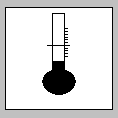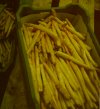| Asparagus | [German version] |
Table of contents |
|
| General: | ||
| Product information | ||
| Packaging | ||
| Transport | ||
| Container transport | ||
| Cargo securing | ||
Product information
Product name
| German | Spargel |
| English | Asparagus |
| French | Asperge |
| Spanish | Espárrago |
| Scientific | Asparagus officinalis |
| CN/HS number * | 0709 20 00 |
(* EU Combined Nomenclature/Harmonized System)
Product description
Asparagus, which comes originally from the Middle East, belongs to the lily family (Liliaceae) and has been cultivated for over 5000 years.
During growth, the stalk shoots (asparagus spears) sprout upright out of the rootstock (rhizome). The tip (head) of the spear, which is approx. 20 – 30 cm long, is covered with small scale-like leaves. Depending on the variety, the plants are cultivated in raised mounds or level beds.
Asparagus is a bush-type plant. After harvest, the shoots develop into shrub-like plants, ensuring the absorption of nutrients. In the autumn, the above-ground parts die back. The rhizomes regenerate after the end of harvest, so allowing the regrowth of strong asparagus plants.
Asparagus is considered a particularly healthy vegetable, due to the wide range of nutrients and minerals and high vitamin content.
Differing cultivation and harvesting methods result in the following three color variants:
| „Blanched or white asparagus“: Blanched asparagus is grown in raised mounds. As soon as the tip peeks through the soil of the mound, the asparagus is harvested (cut). Immediate harvesting prevents the asparagus from changing color. |
|
| „Purple asparagus“: If asparagus is not cut immediately after its tip emerges from the soil, the part of the plant above ground turns purple to blue, as the pigment anthocyanin is formed by exposure to sunlight. |
|
| „Green asparagus“: Green asparagus is grown in level beds where it is exposed to sunlight. Firstly, the pigment anthocyanin forms, resulting in purple coloring and then the asparagus turns green due to chlorophyll formation. |
Quality / Duration of storage
The quality of asparagus cannot be determined from its color, as this mainly depends on the cultivation and harvesting methods adopted. Signs of perfect quality are an undamaged, tight head (it must not be open) and straight growth. In addition, asparagus must not be woody or exhibit any shriveled or discolored cut ends.
Postharvest, asparagus is washed briefly under running water and then cooled down immediately. To ensure that the product does not become too hot, harvesting should where possible be performed in the morning and evening.
Asparagus must never be soaked or its quality will be degraded. Too long a period of soaking produces the following symptoms:
| water can be squeezed from the scale-like leaves at the tip. | |
| the spears take on a gray or yellowish color. | |
| when rubbed together, the spears no longer „crackle“. | |
| the asparagus acquires a musty odor. | |
| spots develop on the asparagus. |
Excessively thin asparagus spears point to cultivation under excessively dry conditions.
Various sources state maximum duration of storage as follows:
| Temperature | Rel. humidity | Max. duration of storage | Source |
|---|---|---|---|
| 2.2°C | 93% | 14 – 21 days | [1] |
| 0.5 – 1°C | 95% | 14 days | [5] |
| 0.5 – 1°C | > 90% | 21 – 28 days | [12] |
Where controlled atmosphere transport is used, the transport and storage duration of asparagus may be extended. The following parameters apply in such a case [16]:
| Temperature | Rel. humidity | O2 | CO2 | Suitability for controlled atmosphere |
|---|---|---|---|---|
| 1.1 – 2.2°C | 90 – 95% | 20% | 5 – 10% | good |
Intended use
Asparagus is a delicacy and is mainly served cooked as a starter, side-dish or with ham and sauce as a main dish. Asparagus is also processed for canning and used for salads, soups etc..
Figures
(Click on the individual Figures to enlarge them.)
 Figure 1 |
 Figure 2 |
Countries of origin
This Table shows only a selection of the most important countries of origin and should not be thought of as exhaustive.
| Europe | Germany, France, Netherlands, Belgium, Spain, Hungary, Greece, Poland |
| Africa | South Africa |
| Asia | Taiwan, China |
| America | USA, Argentina, Chile, Mexico, Peru |
| Australia |
Back to beginning
Packaging
Asparagus is packaged loose or in bundles in cartons, fruit crates, crates, trays and baskets made of wood or plastic. The content varies, depending on the type of packaging, from 500 g (trays, bundles) to 10 kg (boxes, fruit crates). During transport, the product should be covered with perforated film, to prevent drying-out and quality impairment. The possible deposition of moisture on the inside of the film does not impair quality, but rather assists in keeping the product fresh.
 Figure 2a |
Back to beginning
Transport
Symbols
 General cargo |
 Temperature-controlled |
Means of transport
Ship, truck, railroad, aircraft
Container transport
Refrigerated container with fresh air supply or controlled atmosphere.
Cargo handling
Since asparagus is sensitive to impact, it must be handled with appropriate care.
The required refrigeration temperature must always be maintained, even during cargo handling.
In damp weather (rain, snow), the cargo must be protected from moisture, as there is otherwise a risk of premature spoilage (the asparagus spears become rubbery and mushy).
Stowage factor
| 2.50 m3/t (boxes) [1] | |
| 1.40 m3/t (cartons) [1] |
Stowage space requirements
Cool
Segregation
Marker pen, oil crayon
Cargo securing
Because of its considerable impact- and pressure-sensitivity, packages of this cargo must be secured in such a way that they are prevented from damaging each other. Spaces between packages or pallets must be filled, to prevent slippage or tipping. By selecting the correct packaging size or cargo unit (area module or area module multiple), holds can be tightly loaded (without spaces).
Back to beginning
Risk factors and loss prevention
RF Temperature
Asparagus requires particular temperature, humidity/moisture and ventilation conditions (SC VII) (storage climate conditions).
A written cooling order must be obtained from the consignor before loading is begun. This order must always be complied with during the entire transport chain.
The following Table merely constitutes an estimate of appropriate temperature ranges. Temperatures may deviate from these values, depending on the particular transport conditions.
| Designation | Temperature range | Source |
|---|---|---|
| Travel temperature | 1.1 – 2.2°C | [1] |
| 0.5 – 1°C | [5] | |
| 0.5 – 1°C | [12] |
At 0°C, asparagus suffers chilling damage.
Back to beginning
RF Humidity/Moisture
Asparagus requires particular temperature, humidity/moisture and ventilation conditions (SC VII) (storage climate conditions).
| Designation | Humidity/water content | Source |
| Relative humidity | 93% | [1] |
| 95% | [5] | |
| > 90% | [12] | |
| Water content | 90 – 93.6% | [1] |
| Maximum equilibrium moisture content | 90% | [1] |
Moisture (seawater, rain and condensation water) may lead to wetting damage, so causing the asparagus spears to become rubbery and mushy. This may often be observed if the ends of the asparagus bundles are packaged in paper sleeves to keep the cut surfaces fresh. However, in the case of excessively long storage, the asparagus ends become soft and unattractive.
Back to beginning
RF Ventilation
Asparagus requires particular temperature, humidity/moisture and ventilation conditions (SC VII) (storage climate conditions).
Recommended ventilation conditions: circulating air, 40 – 60 circulations/hour with continuous supply of fresh air, to prevent excessive concentrations of CO2, ethylene and other gases.
Back to beginning
RF Biotic activity
Asparagus displays 2nd order biotic activity.
Asparagus is a living organ in which respiration processes predominate, because its supply of new nutrients has been cut off by separation from the parent plant.
Care of the cargo during the voyage must be aimed at controlling respiration processes (release of CO2, water vapor, ethylene and heat) in such a way that the cargo is at the desired stage of ripeness on reaching its destination. Inadequate ventilation may result in fermentation and rotting of the cargo as a result of increased CO2 levels and inadequate supply of atmospheric oxygen (see Ventilation).
Back to beginning
RF Gases
| CO2 evolution | During storage, asparagus evolves CO2 by respiration processes. |
| Upper limit of permissible CO2 content | 5 – 10 vol.% |
| Ethylene evolution | |
| Active behavior | The rate of ethylene production is very low, being below 0.1 µl/kg*h [16]. |
| Passive behavior | Asparagus is moderately sensitive to ethylene [16]. (allelopathy). |
If ventilation has been inadequate (frost) or has failed owing to a defect, life-threatening CO2 concentrations or O2 shortages may arise. Therefore, before anybody enters the hold, it must be ventilated and a gas measurement carried out.
Back to beginning
RF Self-heating / Spontaneous combustion
No risk.
Back to beginning
RF Odor
| Active behavior | Asparagus does not release any odor. |
| Passive behavior | Asparagus is sensitive to unpleasant or pungent odors. |
Back to beginning
RF Contamination
| Active behavior | Asparagus does not cause contamination. |
| Passive behavior | Asparagus is sensitive to dirt, fats and oils. The holds or containers must accordingly be clean and in a thoroughly hygienic condition before loading. |
Back to beginning
RF Mechanical influences
Because of its high impact- and pressure-sensitivity, asparagus must be treated with great care during cargo handling, transport and storage, since otherwise it may spoil prematurely. The following Figures show just how easily asparagus breaks under mechanical loads, so suffering considerable losses in quality or becoming unsalable.
 Figure 3 |
 Figure 4 |
Back to beginning
RF Toxicity / Hazards to health
If ventilation has been inadequate (frost) or has failed owing to a defect, life-threatening CO2 concentrations or O2 shortages may arise. Therefore, before anybody enters the hold, it must be ventilated and a gas measurement carried out. The TLV for CO2 concentration is 0.49 vol.%.
Back to beginning
RF Shrinkage/Shortage
Film-packed asparagus loses the least weight.
Back to beginning
RF Insect infestation / Diseases
Asparagus beetle: black/white/red-spotted beetle which attacks asparagus.
Asparagus fly: the larvae of the asparagus fly attack the shoots and cause them to wither.
Asparagus rust: asparagus rust is caused by the rust fungus Puccinia asparagi, which attacks the spears.
The quarantine regulations of the country of destination must be complied with and a phytosanitary certificate may have to be enclosed with the shipping documents. Information may be obtained from the phytosanitary authorities of the countries concerned.
Chilling damage: asparagus suffers chilling damage at 0°C. The vegetable loses its freshness and crunchiness and becomes rubbery instead. At temperatures below 0°C, asparagus very rapidly freezes and dies.
Back to beginning
